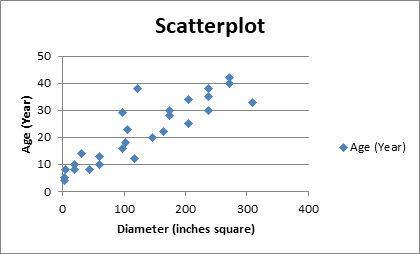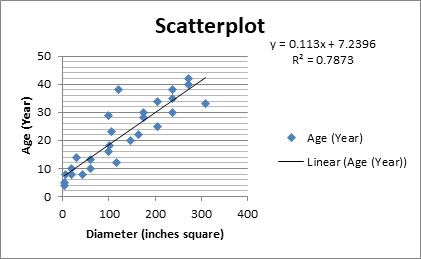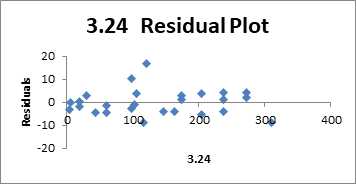
Concept explainers
(a)
To find out does the
(a)
Answer to Problem 20RE
Yes, it looks better.
Explanation of Solution
It is given in the question that the researchers want to find out can we estimate the tree’s age simply from its diameter or not. Thus, the diameter and ages of

Thus, now the scatterplot is straightened and yes it looks better than the previous scatterplot as the points are more near and in a straight line.
(b)
To create a model that predicts age from the square of the diameter.
(b)
Answer to Problem 20RE
Explanation of Solution
It is given in the question that the researchers want to find out can we estimate the tree’s age simply from its diameter or not. Thus, the diameter and ages of

Thus, the regression line is as follows:
(c)
To check the residual plot for this new model and explain is this model more appropriate and why.
(c)
Answer to Problem 20RE
Yes, it is more appropriate.
Explanation of Solution
It is given in the question that the researchers want to find out can we estimate the tree’s age simply from its diameter or not. Thus, the diameter and ages of

Thus, we can say by looking at the new residual plot that yes, this model is more appropriate model because the residual do not form a curve anymore as in the previous plot.
(d)
To estimate the age of a tree
(d)
Answer to Problem 20RE
The estimated age of the tree is
Explanation of Solution
It is given in the question that the researchers want to find out can we estimate the tree’s age simply from its diameter or not. Thus, the diameter and ages of
Thus, the estimated the age of a tree
The estimated age of the tree is
Chapter PII Solutions
Stats: Modeling the World Nasta Edition Grades 9-12
Additional Math Textbook Solutions
Fundamentals of Statistics (5th Edition)
Essentials of Statistics (6th Edition)
Elementary Statistics (13th Edition)
Introductory Statistics (10th Edition)
 MATLAB: An Introduction with ApplicationsStatisticsISBN:9781119256830Author:Amos GilatPublisher:John Wiley & Sons Inc
MATLAB: An Introduction with ApplicationsStatisticsISBN:9781119256830Author:Amos GilatPublisher:John Wiley & Sons Inc Probability and Statistics for Engineering and th...StatisticsISBN:9781305251809Author:Jay L. DevorePublisher:Cengage Learning
Probability and Statistics for Engineering and th...StatisticsISBN:9781305251809Author:Jay L. DevorePublisher:Cengage Learning Statistics for The Behavioral Sciences (MindTap C...StatisticsISBN:9781305504912Author:Frederick J Gravetter, Larry B. WallnauPublisher:Cengage Learning
Statistics for The Behavioral Sciences (MindTap C...StatisticsISBN:9781305504912Author:Frederick J Gravetter, Larry B. WallnauPublisher:Cengage Learning Elementary Statistics: Picturing the World (7th E...StatisticsISBN:9780134683416Author:Ron Larson, Betsy FarberPublisher:PEARSON
Elementary Statistics: Picturing the World (7th E...StatisticsISBN:9780134683416Author:Ron Larson, Betsy FarberPublisher:PEARSON The Basic Practice of StatisticsStatisticsISBN:9781319042578Author:David S. Moore, William I. Notz, Michael A. FlignerPublisher:W. H. Freeman
The Basic Practice of StatisticsStatisticsISBN:9781319042578Author:David S. Moore, William I. Notz, Michael A. FlignerPublisher:W. H. Freeman Introduction to the Practice of StatisticsStatisticsISBN:9781319013387Author:David S. Moore, George P. McCabe, Bruce A. CraigPublisher:W. H. Freeman
Introduction to the Practice of StatisticsStatisticsISBN:9781319013387Author:David S. Moore, George P. McCabe, Bruce A. CraigPublisher:W. H. Freeman





